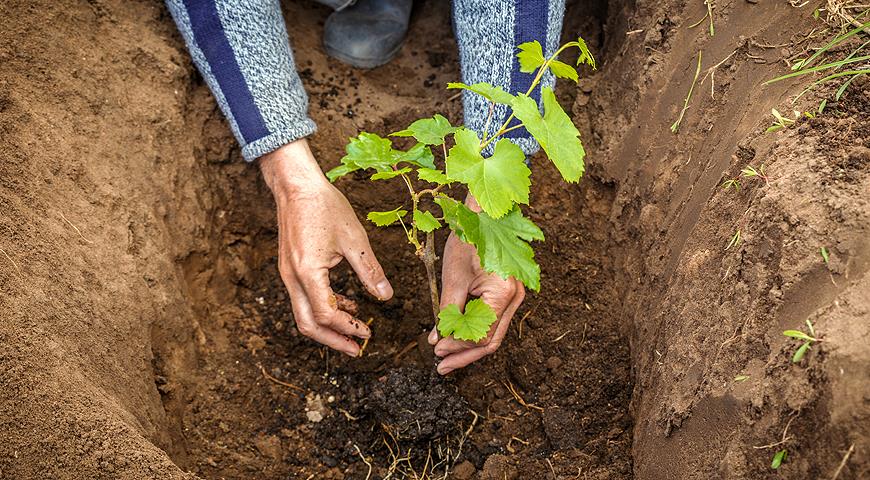 Grapes - a powerful plant with highly developed roots, which is not so easy to transplant. Therefore, it is planted immediately in such a way that in the future it does not touch. However, there are situations when a transplant is necessary.
Grapes - a powerful plant with highly developed roots, which is not so easy to transplant. Therefore, it is planted immediately in such a way that in the future it does not touch. However, there are situations when a transplant is necessary.
In this case, you need to perform this complex procedure competently so as not to lose the plant.
Content
Why transplant grapes
Grapes are transplanted in cases where, for example, a redevelopment of the site has occurred, or the bush has grown too much and began to lay claim to new territories. Another reason for moving the crop to a new place may be the poor growth of the shrub (perhaps it does not have enough light and heat, or the soil composition is not suitable).
Experts recommend replanting only young grapes, which are no more than five years old. Bushes of one year take root most quickly on the new permanent residence. Older plants are undesirable to touch. There is a big risk that the roots will be damaged during the excavation and the plant will die.
Seat selection
 A plot for the vineyard is prepared for the season ahead. For culture, a well-lit, windless place is chosen. Preferably, this is the southwest side. Although many argue that grapes are not picky about the composition of the soil, it grows better on light loam and chernozem, does not like clay soils and salt marshes. The sandstone culture also feels uncomfortable. It is also important that groundwater flows at least two meters from the surface of the earth.
A plot for the vineyard is prepared for the season ahead. For culture, a well-lit, windless place is chosen. Preferably, this is the southwest side. Although many argue that grapes are not picky about the composition of the soil, it grows better on light loam and chernozem, does not like clay soils and salt marshes. The sandstone culture also feels uncomfortable. It is also important that groundwater flows at least two meters from the surface of the earth.
When planning a garden, it must be taken into account that grapes need a lot of free space. It should not be placed next to other tall crops, otherwise there will be competition for nutrients.
Transplant Dates
Many gardeners are wondering: when is the best time to transplant grapes? The answer to this question lies in the biological characteristics of culture. The fact is that the root system of a plant is never at rest. Even in winter, when the aboveground part "sleeps", the roots continue the growth process. But only on condition that it is warm and humid in the depths of the soil. This condition can be both in spring and autumn. It turns out that it is possible to transplant grapes when the soil warms up above 8 degrees Celsius and in the fall, when the stems enter the dormant stage and the plant begins to spend all its strength on enhanced root growth.
However, it is worth considering another factor - the climatic features of the region. If this is the north of the country, where winters are frosty and long, then the land there quickly freezes, which prevents the roots from developing. This means that if you transplant an autumn bush, it will not have time to take root before the onset of frost, since the roots will stop growing and the plant will no longer receive nutrition. It turns out that for the northern regions, as well as the central part of Russia, it is preferable to transplant grapes in the spring. There is an opinion that this should be done as early as possible, almost in the month of March. But it is not so.
Remember, even if it has become warm, this does not mean that the soil has thoroughly warmed up.A transplant is carried out only when the soil temperature is not lower than 10 degrees heat. For the Urals, this is mid-May - early June, for Moscow region and middle strip - mid-April.
In the southern regions, it is preferable to transplant grapes to another place in autumn. This is due to the fact that when transplanting at another time (for example, in spring or summer), due to the intense heat and lack of water, the bush may not take root. The optimal time for the procedure is mid-October.
The specifics of the fall transplant
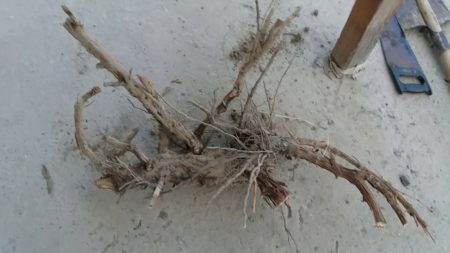 Transplanting grapes to a new place in autumn should be carried out only after all leaves have fallen. This time is marked by the onset of the resting phase, the vegetation ends. But this applies only to the upper part of the plant, while the roots continue to develop. If the autumn is warm (or the vineyard grows in the southern part of the country), then a transplant can be arranged until the beginning of November. But you can’t procrastinate too much: grapes must be transplanted at least two weeks before the onset of persistent cold weather. If you plant it later, then most likely the plant will die.
Transplanting grapes to a new place in autumn should be carried out only after all leaves have fallen. This time is marked by the onset of the resting phase, the vegetation ends. But this applies only to the upper part of the plant, while the roots continue to develop. If the autumn is warm (or the vineyard grows in the southern part of the country), then a transplant can be arranged until the beginning of November. But you can’t procrastinate too much: grapes must be transplanted at least two weeks before the onset of persistent cold weather. If you plant it later, then most likely the plant will die.
Spring transplant: basic rules
In the spring, all procedures with plants begin to be carried out before the sap flow begins and the buds wake up. But you also need to consider the readiness of the soil for "work". Too early to start a transplant is not worth it - in a cold soil the roots will not have time to wake up and begin to nourish the plant's ground organs, from which it can die. In most cases, the conditions for planting seedlings have to be created independently: before planting, the soil is shed with hot water to keep it warm. And after planting, the stems are covered with cold soil so that the sun's heat does not awaken the kidneys ahead of time.
For spring planting of bushes of grapes, planting pits are prepared in the fall. An 80-centimeter hole is dug under each seedling and filled with organic fertilizer (humus, compost). Then half covered with fertile soil. In spring, when landing on the bottom of the pit, a layer of soil mixture is poured, consisting of sheet soil, peat and mineral fertilizers. In spring, seedlings take root quickly and already in summer are overgrown with the first side shoots and lush bright green leaves.
Summer transplant
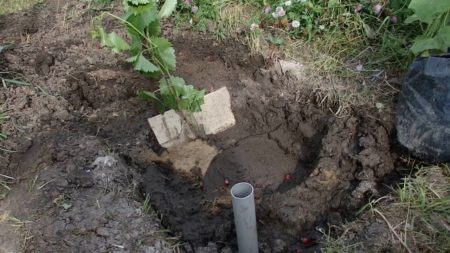 For the summer procedure, landing pits are prepared in the same way as in the fall. They are dug up a month before planting. A fertile mixture is also prepared, by which seedlings will be backfilled. Since in summer period there is a lack of moisture, then the soil before planting is watered abundantly. Immediately after planting the plants in a new place, the site is covered with compost or straw, so that the roots do not feel thirst during the engraftment period. After transplanting, seedlings must be pritenit from excessive receipt of ultraviolet radiation to plants. You can not plant grapes close to tall fruit trees and shrubs.
For the summer procedure, landing pits are prepared in the same way as in the fall. They are dug up a month before planting. A fertile mixture is also prepared, by which seedlings will be backfilled. Since in summer period there is a lack of moisture, then the soil before planting is watered abundantly. Immediately after planting the plants in a new place, the site is covered with compost or straw, so that the roots do not feel thirst during the engraftment period. After transplanting, seedlings must be pritenit from excessive receipt of ultraviolet radiation to plants. You can not plant grapes close to tall fruit trees and shrubs.
Grape transplant of different ages
Grapes of different ages have their own biological characteristics that must be taken into account when transplanting. Rules for moving grapes depending on age:
- Annual grape. For propagation grapes use cuttings - Small twigs that are planted in the school for rooting. By the end of the season, cuttings are overgrown with a weak root system and 2-4 green shoots. Rooted cuttings are transplanted for permanent residence in spring or autumn. Their survival rate is very high.
- Two year old grape. The plant is a pretty seedling with a well-developed root system and stems. Grape seedlings are transplanted to a new place in most cases without problems. The main thing is to trim the shoots, leaving one or two eyes on the stems.Of these, shoots will subsequently appear, which in the future will make up the main branches of the bush.
- Three year old grape. This is a fairly mature plant with lignified long sleeves and strong developed roots that go deep underground. Carry out a transplant of fruiting grapes in the fall. Shoots must be cut to four eyes, since the roots will not immediately be able to nourish a strongly overgrown plant.
- Four to five year old grapes. A mature plant that is very difficult to dig up, so kA roots can go underground under 100 centimeters. They dig out the bush carefully, taking out the entire root system from the earth with an earthen lump. Shoots shorten to 4-6 eyes.
- Grapes older than five years. This is an old plant that is difficult to tolerate various manipulations. Therefore, before transplanting it, you should consider whether it is worth touching it at all. Firstly, to dig out the root system without damaging it is almost impossible. Secondly, the ground part has already grown too large and will have to be completely removed. It’s better to propagate such grapes with the help of layering or cuttings.
How to transplant grapes
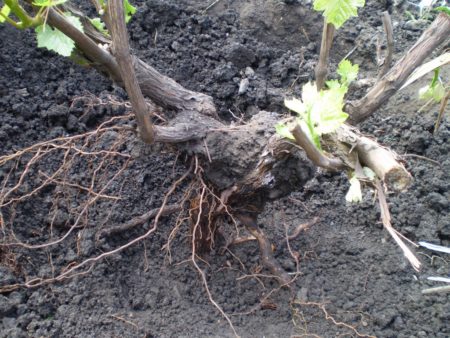 This culture can be moved to a new place of growth without losing varietal traits. For this, various parts of the plant are used.
This culture can be moved to a new place of growth without losing varietal traits. For this, various parts of the plant are used.
Transplanting layering
The vine of the old grapes can be used to obtain new fruiting bushes. It is believed that this method of reproduction is the most affordable and effective.
Technique of reproduction of grapes layering:
- As a "raw material" pick up a long biennial developed lash with kidneys.
- The shoot is laid in a shallow narrow groove, sprinkled on top with a layer of earth.
- Planting abundantly watered with water.
- During the summer, buds located on the vine will sprout. Escape will get its root system.
You can transplant grapes to a new place in the fall. For this, layering is separated from the parent plant and planted as a separate plant.
As layering, you can use not only a whole vine, but also short green shoots. The essence of the method is to bend the ends of such shoots to the ground and dig them in, securely fastening the twigs so that they do not come out of the ground. Already in the fall, the ends will be overgrown with roots, and then the branches can be cut off from the mother bush. Transplanting rooted cuttings can be done in the fall.
Planting cuttings
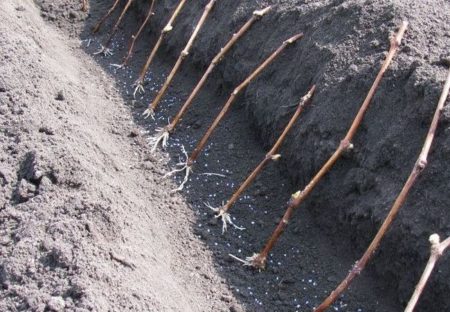 Chubuki cut from one long young (annual) vine. It is important that there are 2-3 peepholes on each handle. Cuttings at one end are inserted into a moist, loose substrate for rooting.
Chubuki cut from one long young (annual) vine. It is important that there are 2-3 peepholes on each handle. Cuttings at one end are inserted into a moist, loose substrate for rooting.
After a few weeks, the first leaves appear from the eyes. This means that the root system has already formed. Then Chubuki transplanted to the school (a separate bed). There they will grow until next season. They can grow in greenhouse conditions or at home. At the age of one year, seedlings are moved to a permanent place of residence. Immediately after transplantation, they are protected from sunlight. With spring planting, by the autumn they will already take root well and will yield the first crop next year.
Katavlak
A kind of rooting layering. This method is used to rejuvenate old grapes or when you need to thicken a vineyard. For this, the lignified vines of an old vine bush are laid completely in the ground. Roots will grow from sleeping sleeves of the sleeves in a few years.
Katavlak can be done in several ways. The vines can be laid in one line, on top of each other or in different directions.In any case, the procedure includes fertilizer with humus and mineral compounds. The vines are laid in deep grooves on a fertile, well-fertilized soil layer. In certain places, the ends of young vines are brought to the surface - they will be the main component of the renewed bush. Powerful fruitful shoots will grow from the buds that have remained above the surface of the earth in subsequent years. They will bring a new crop in the second year of planting.
How to transplant grapes in autumn
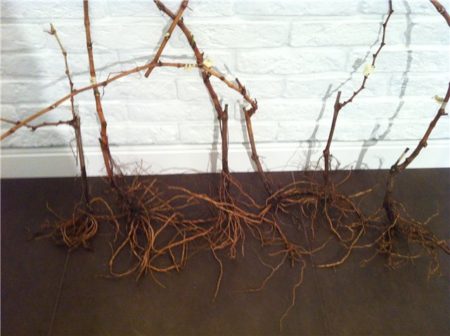 The transplant procedure requires lengthy preparatory measures. Planting pits are prepared in advance, preparatory procedures of the plant itself are carried out.
The transplant procedure requires lengthy preparatory measures. Planting pits are prepared in advance, preparatory procedures of the plant itself are carried out.
Grape preparation
Before you start digging plants, their ground part is shortened. Long shoots (vines) completely cut off. Prepared bushes have two short young sleeves, each of which has 2-3 buds. At the shoots themselves, the apical part is also shortened, and the places of the cuts are treated with garden varieties or crushed coal.
3-4 days before excavation, the soil is abundantly watered, so that, firstly, it is easier to pull out the bush without damaging the roots, and secondly, so that the moist earthen lump reliably adheres to the roots. In young bushes, the diameter of the coma is about 30 centimeters, in old ones - 45-50 centimeters. It is at this distance from the base of the stem that you need to start digging bushes. They dig in the plants from different sides, then to pick up the root with bayonets of shovels and pull them to the surface without damage. If the transplant is carried out with a lump of earth, then the roots that stick out beyond it are cut, and the plant is placed on a flat surface (plywood, shovel). So that the lump does not collapse, it is carefully wrapped with some kind of material.
Landing pit preparation
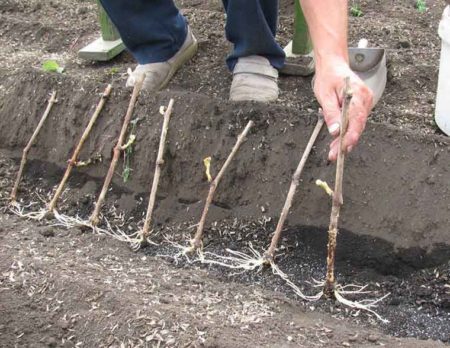 The size of the pit depends on the maturity of the grape bush. If he is young enough, and the roots have not grown too much, then the depth of the pit can be 50-60 centimeters. An adult bush is planted in a pit 100 centimeters deep. The depth of the pits also depends on the composition of the soil. If it is loose, fertile, then the roots in such soil will grow rapidly vertically. It is more difficult for them to develop in dense soil, and therefore it is better to dig a bigger hole so that they have room to grow. In addition, on clay soils, it is necessary to arrange a drainage layer.
The size of the pit depends on the maturity of the grape bush. If he is young enough, and the roots have not grown too much, then the depth of the pit can be 50-60 centimeters. An adult bush is planted in a pit 100 centimeters deep. The depth of the pits also depends on the composition of the soil. If it is loose, fertile, then the roots in such soil will grow rapidly vertically. It is more difficult for them to develop in dense soil, and therefore it is better to dig a bigger hole so that they have room to grow. In addition, on clay soils, it is necessary to arrange a drainage layer.
The distance between the bushes should be at least two meters. For filling the bushes, a soil mixture is prepared consisting of turf, peat, ash and phosphorus fertilizers. River clay is added to clay soil.
How to dig bushes
Transplant grapes in three ways:
- with a lump of earth;
- with partially bare roots;
- with an open root system.
Transplant with a lump of land
Landing by transshipment is more preferable, since with this method the root system remains intact. In addition, the roots take root in a new place faster even without any additional procedures.
Transplant technology:
- The pit is half covered with soil.
- The plant is not watered a couple of days before the excavation so that the lump does not fall apart.
- An earth ball along with the roots is inserted into the hole.
- Roots are watered with a root stimulant (Kornevin, Heteroauxin).
- All voids around the coma are covered with fertile soil, ramming each layer.
- Completely covering the roots, form a near-trunk circle.
- The site is abundantly watered so that the poured earth grabs with a lump.
Grape transplant with half-bare roots or a fully open root system
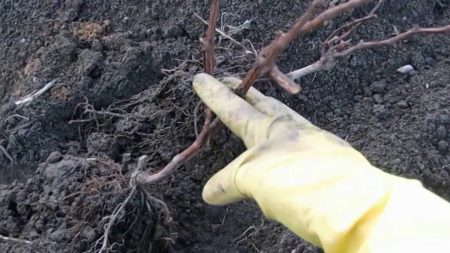 It happens that during the excavation of the bush, the lump partially or completely fell apart. This happens if the soil was too dry or the root system grew too much in different directions and the earth could not "envelop" it.If large pieces of dry earth remain on the root part, then it is better to remove them by gently tapping them with a stick so that they collapse.
It happens that during the excavation of the bush, the lump partially or completely fell apart. This happens if the soil was too dry or the root system grew too much in different directions and the earth could not "envelop" it.If large pieces of dry earth remain on the root part, then it is better to remove them by gently tapping them with a stick so that they collapse.
Transplant technology:
- For an open root system, the depth of the pit should not be too large.
- The roots are soaked before planting in a growth stimulator. They are disinfected in a manganese solution. Dip into a clay-dung mash so that they are wet at the moment of adhesion to the ground.
- If the roots have time to dry, they are shortened a little.
- At the bottom of the pit a small mound is poured onto which a bush is placed. The roots are spread on the slopes of the knoll so that their ends look only down.
- The pits are covered with a soil mixture, shaking the plant slightly so that the voids clog the ground.
- Asleep, the bush is watered. If the landing is spring, then the trunk circle is mulched.
Grape Care after Transplanting
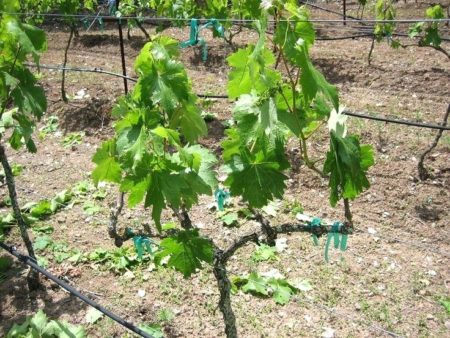 Care measures for transplanted grapes depend on the time of transplant. Autumn planting necessarily shelter for the winter. A weakened plant requires reliable protection against frost. Shelter involves filling the bases of bushes and tree trunks with earth or straw (sawdust, peat). The apical part is covered with ultrasound. To prevent fragile seedlings from breaking under the weight of non-woven material, a frame is installed above them, which is wrapped with agrofiber. You can sprinkle grass or hay on top.
Care measures for transplanted grapes depend on the time of transplant. Autumn planting necessarily shelter for the winter. A weakened plant requires reliable protection against frost. Shelter involves filling the bases of bushes and tree trunks with earth or straw (sawdust, peat). The apical part is covered with ultrasound. To prevent fragile seedlings from breaking under the weight of non-woven material, a frame is installed above them, which is wrapped with agrofiber. You can sprinkle grass or hay on top.
In the spring, shelter is removed, but they do it gradually. First, the base of the bush is exposed, and only then, after a few days, the stems. Bushes protect against aggressive sunlight for a couple of weeks, which, coupled with frost, can cause burns on plants. It is preferable to pull a protective tent over the bushes. With the arrival of heat, the plants “wake up”, sap flow begins, the buds swell. The fact that the grape bushes have taken root will be prompted by the appearance of the first leaves. During this period, it is important to fertilize with nitrogen fertilizers, which will stimulate the seedlings to build up green mass. Further, vineyard care consists of traditional agricultural activities related to watering, croppedpest treatment.
When planting grapes in summer, plants are immediately mulched to protect the earth from excessive evaporation of moisture. If grapes are transplanted in the spring, then the soil contains sufficient moisture for the normal development of plants. Therefore, watering the vineyard too often is not required. It is optimal to “water” the plants once every 10 days. During summer planting, seedlings should be watered more often, every 6-7 days. Rooted bushes are rarely watered, but abundantly, spilling directly the base of the bush. It is best to arrange a drip irrigation system or small grooves around the bushes, through which moisture will flow immediately to the roots. Water consumption per plant is about 20 liters. During flowering and fruit ripening, watering is stopped to avoid cracking for a year. The last watering is carried out in August. If there is little rainfall in the fall, then in October they carry out water-charging irrigation.
Top dressing of summer landings is carried out in the fall. It is necessary to increase the vitality of plants in the winter. This time they dispense with nitrogen fertilizers, as the plants must retire, stop vegetating. Increasing the chances of survival will help the introduction of phosphorus-potassium compounds and ash. Grapes respond well to foliar top dressing complex mineral fertilizers. And organic mulch (compost, humus) will help strengthen the stems and increase the level of shoot growth.
With autumn planting, insecticides are sprayed in the spring. This is necessary in order to destroy insect pests that overwintered in the soil and with the arrival of heat begin to climb on young stems of grapes.To protect, when neither the disease nor the insects had time to penetrate the vegetation cover, it is enough to treat the bushes with insecticides and fungicides of a contact action.
Common grape transplant errors
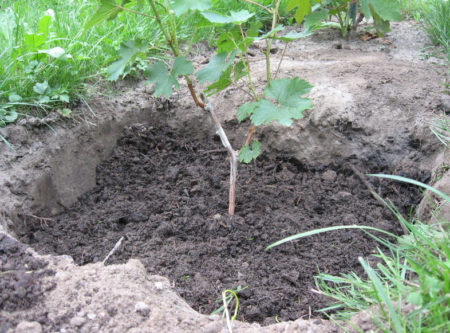 Many summer residents do not succeed. Even successfully grown cuttings and seedlings after transplantation dramatically lose their healthy appearance, stop growing, dry out and die. This is mainly due to improper preparation of planting material, a shift in the timing of planting.
Many summer residents do not succeed. Even successfully grown cuttings and seedlings after transplantation dramatically lose their healthy appearance, stop growing, dry out and die. This is mainly due to improper preparation of planting material, a shift in the timing of planting.
The main mistakes:
- Strong cropping. When transplanting, it is recommended to prune the roots. But if only young, green ones are left at the base of the roots, while removing the middle and heel, then they will not be able to bear "such a burden." A weak root system cannot well nourish the terrestrial part, from which it ceases to develop, grapes do not take root. Remember, the roots only need to be trimmed a little so that they clutch faster with the ground.
- Transplanting old grapes. The grapes of the first three years of life take root well. Every year, his regenerative abilities become worse. Grapes older than five in 99% of cases do not take root at all. Therefore, for transplantation, you need to choose only young and healthy grapes.
- Transplants are not on time. If you do not guess the timing and transplant much earlier or later than the period when the plant goes into hibernation or wakes up, on the contrary, the chances of engraftment fall sharply. It is important to determine the time for the movement: grape transplant in autumn should be carried out 2-3 weeks before the onset of cold weather, and in spring - no later than the start of sap flow.
- Unsuitable place for transplant. If grapes are planted on a site where this crop had previously grown, then the land in this place is very depleted. In addition, the ground may be causative agents of grape disease or pests who are happy to eat a new victim. Experts recommend planting grape seedlings in a new area where this crop has never grown before.
Conclusion
Not every gardener can risk a vineyard transplant, because it is a laborious and long-term process that requires certain knowledge in the field of viticulture. If the grape does not interfere and grows well in the same place, then we advise you not to touch it - let it grow and please with its harvest. However, if plant transplantation is a necessary measure, then before embarking on this business, it is necessary to study all the information regarding this issue. Only a thoughtful and serious approach to how to transplant grapes to another place will help keep the grapes healthy, strong and fruitful even after transplanting.




 Non-covering winter-hardy grape varieties for Moscow region
Non-covering winter-hardy grape varieties for Moscow region How to keep the vine in winter
How to keep the vine in winter When can I transfer grapes to another place in the fall
When can I transfer grapes to another place in the fall How to cover and prepare grapes for the winter in the suburbs
How to cover and prepare grapes for the winter in the suburbs